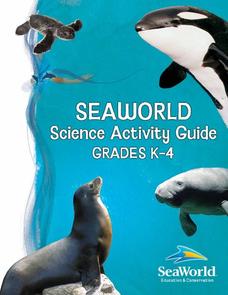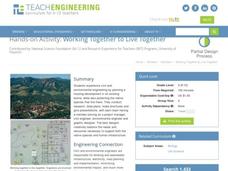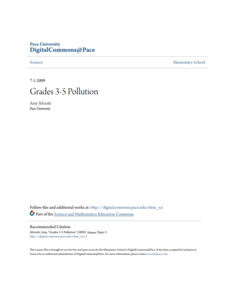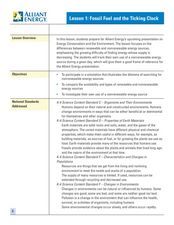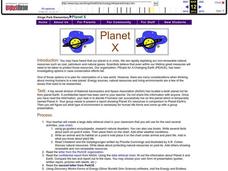Curated OER
Using Abiotic and Biotic Parameters to Monitor Air Quality
Students identify the abiotic factors that influence a river or stream and the organisms that live in it. They measure several abiotic and biotic parameters to gauge water quality. Students examine the biotic environment by identifying...
Curated OER
Understanding Reconstruction in South Carolina
Eighth graders interpret historical evidence presented in primary and secondary resources. In this Reconstruction activity, 8th graders research the role of Reconstruction in South Carolina by simulating the environment of East Bay...
Curated OER
Water Wars: Responsibility in the Age of Globalization
Students explore the concept of water as a resource and as a human right. In this conservation instructional activity, students record and chart personal water usage and consumption then brainstorm ways in which to responsibly reduce...
Curated OER
Using the Land
In this land worksheet, students review the different ways that land is used such as landfills, topsoil, farmland, and hazardous waste. This worksheet has 13 true or false questions and 1 short answer question.
Curated OER
Migration Isn't Just For The Birds
Fourth graders explore the concepts of conservation using a reading story that describes a flock of geese. The ecosystems are also described in the lesson and the effects of pollution.
Curated OER
Grow Your Own
Students study the growth and care of plants. They take tour of their school site and plant seeds to observe their growth. Afterward, they answer questions about the origin and value of their plants.
Sea World
Seaworld Science Activity
A fun collection of activities about marine life would be a great addition to your elementary science unit. From cute penguins to scary sharks, the unit features crafts, experiments, and basic research projects that will teach your...
Consumers Energy
The Cost of Electricity
How much is your toaster costing you every day? Young environmentalists calculate the monetary costs of household appliances based on their average consumption of wattage.
Virginia Department of Education
Electricity and Magnetism
Take charge of your class and provide them with an electrical experience! Individuals investigate the basic principles of electricity and magnetism by creating a model to test electric current and the amount of electricity generated....
Teach Engineering
Working Together to Live Together
Whose home is it anyway? Design teams plan a housing development in which they must also protect a native species. The teams consist of a project manager, civil engineer, environmental engineer, and graphic designer. Teams present their...
EduGAINs
Go H2O! Investigating Residential Water Systems
Before your learners excuse themselves to get a drink at the water fountain, prompt them to think about where that water comes from. A middle school science lesson encourages groups to research their community's source of drinking water,...
Project WET Foundation
Explore Watersheds
What makes a watershed? What are the natural and human features of a watershed? How do human features affect watersheds? Where can I find my local watershed? These questions are thoroughly explained in an informative watershed interactive.
Curriculum Corner
It's Been a Wildly Exciting Year!
Take time at the end of the year to celebrate the amazing qualities and achievements of your learners with these printable awards. Offering a list of dozens of ways to recognize the individuals in your class, this resource is a...
Pace University
Pollution
Over the course of 10 days, scholars take a pre-assessment to place them in one of three leveled groups. Whole-class and in small groups, pupils take part in read-alouds, field trips, hands-on activities, and complete learning contracts...
CK-12 Foundation
CK-12 Earth Science Concepts for Middle School
Explore a variety of science concepts in an interactive textbook created for middle school scholars. A lengthy table of contents takes readers to pages comprised of a subject overview, outline, and summary. Follow links further to find...
Curated OER
Indigenous Peoples’ Day Lesson Plan
Indigenous Land Guardianship, Settler Colonialism, Racial Capitalism. While the terms may be new to some, they feature in a lesson plan designed for Indigenous Peoples' Day. Young scholars investigate four concepts: Land...
Curated OER
No Fossils in This Fuel!
Learners explain how technology leads to a cleaner environment. They gain hands-on experience with ethanol as a fuel alternative.
Curated OER
Fossil Fuel and the Ticking Clock
Students study energy sources to learn about fossil fuels and environmental concerns. In this energy sources lesson, students watch demonstrations for various energy examples. Students find hidden pennies, make a bar graph on their data,...
Curated OER
Earth Day Lesson
Students analyze Earth science by answering environmental study questions. In this Earth Day instructional activity, students read the book The Lorax and identify the themes within it. Students define several recycling vocabulary terms...
Curated OER
Planet X
Students select a wide variety of presentation methods to compare Planet X and Earth. Students share these with their classmates. Students select other methods to present their ideas about a livable planet for human life forms. ...
Curated OER
Habitats: Rainforest
Students use the internet to find reasons the rainforest is endangered and ways that affects the rest of the world. They read for information, perform experiments, locate rainforests on maps, and write about this ecosystem.
Curated OER
'O'opu Life Cycle
Learners investigate the life cycle of the 'o'opu also known as Hawaiian gobies. In this amphidromous living lesson plan, students discuss the reproductive cycle, create props and an obstacle course to demonstrate the importance of...
Curated OER
Driving Forces Forestry In Canada
Learners discuss the natural and economic impact of forests and forestry. Using given statistics they construct different types of graphs in which they make observations and draw conclusions.
Curated OER
Renewing Our Position
Students engage in a lesson in order to analyze the energy needs of the United States and cover the possible future needs depending on the growth of technology. They cover the alternative energy sources and make presentations of the...






